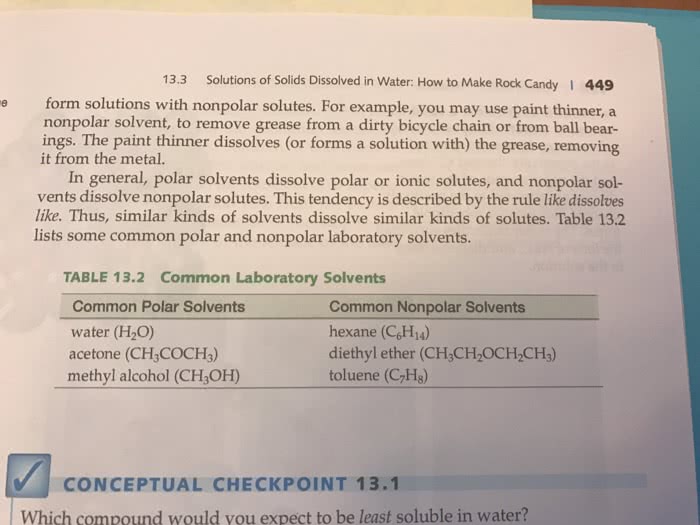CHEM 24112 Lecture Notes - Lecture 30: Formaldehyde, Calcium Chloride, Aqueous Solution

CHEMISTRY 112 – DAY 30 Chapter 15: Sections 1-3
4/2/18
SOLUTIONS AND MASS PERCENT
What is a Solution?
Solution – homogeneous mixture
Solvent – substance present in largest amount
Solutes – other substances in the solution
Aqueous solution – solution with water as the solvent
Solubility of Ionic Substances
Ionic substances break up into individual cations and anions.
Polar water molecules interact with the positive and negative ions of a salt.
Solubility of Polar Substances
Ethanol is soluble in water because of the polar OH bond.
Why is solid sugar soluble in water?
Substances Insoluble in Water
Nonpolar oil does not interact with polar water.
Water-water hydrogen bonds keep the water from mixing with the nonpolar molecules.
How Substances Dissolve
A “hole” must be made in the water structure for each solute particle.
The lost water-water interactions must be replaced by water-solute interactions.
“like dissolves like”
The solubility of a solute is limited.
Saturated solution – contains as much solute as will dissolve at that temperature.
Unsaturated solution – has not reached the limit of solute that will dissolve.
Solutions are mixtures.
Amounts of substances can vary in different solutions.
Specify the amounts of solvent and solutes.
Qualitative measures of concentration
concentrated – relatively large amount of solute
dilute – relatively small amount of solute
find more resources at oneclass.com
find more resources at oneclass.com
Document Summary
Aqueous solution solution with water as the solvent. Ionic substances break up into individual cations and anions. Polar water molecules interact with the positive and negative ions of a salt. Ethanol is soluble in water because of the polar oh bond. Nonpolar oil does not interact with polar water. Water-water hydrogen bonds keep the water from mixing with the nonpolar molecules. A hole must be made in the water structure for each solute particle. The lost water-water interactions must be replaced by water-solute interactions. Saturated solution contains as much solute as will dissolve at that temperature. Unsaturated solution has not reached the limit of solute that will dissolve. Amounts of substances can vary in different solutions. Qualitative measures of concentration concentrated relatively large amount of solute dilute relatively small amount of solute. Example 2: a solution is prepared by mixing 1. 00 g of ethanol, c2h5oh, with 100. 0 g of water. Calculate the mass percent of ethanol in this solution.



